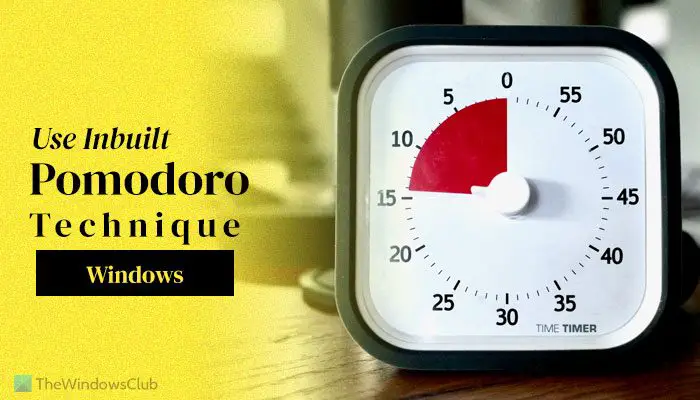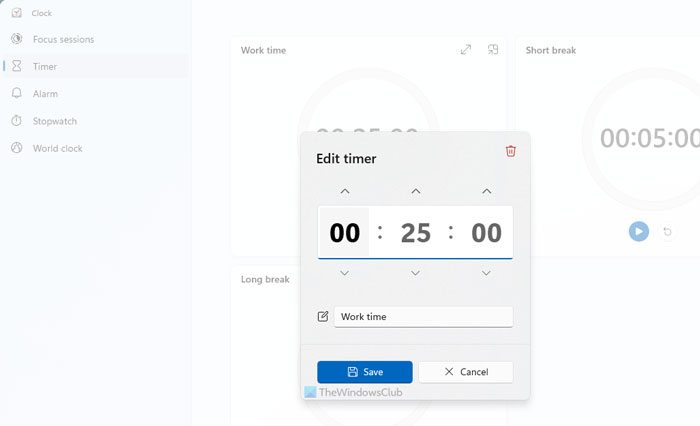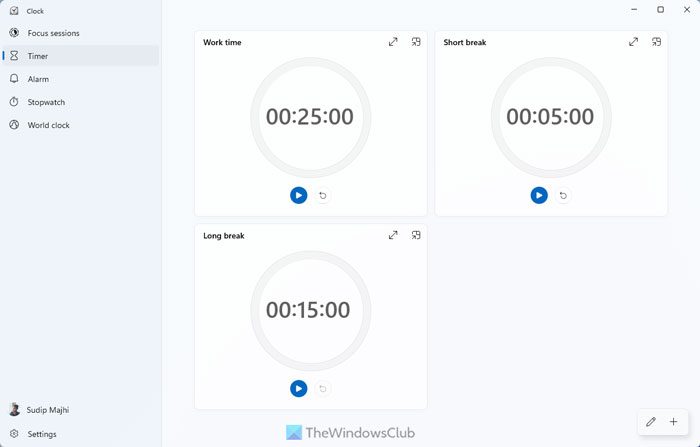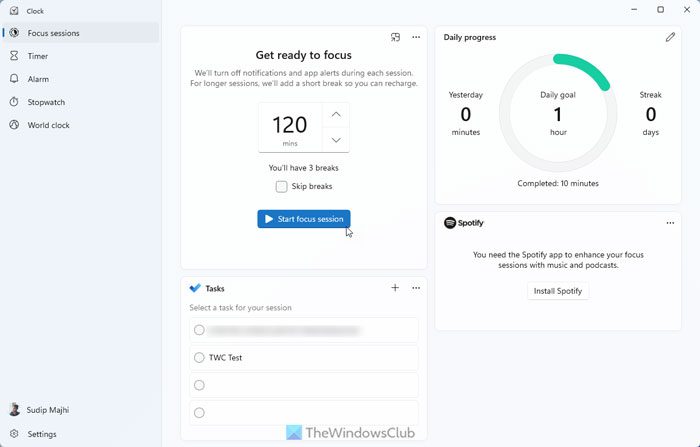How to use built-in Pomodoro technology in Windows 11/10
To use built-in Pomodoro technology in Windows 11 or Windows 10, you can set a timer through the built-in Clock app. This can help you use your time more effectively and improve work efficiency. Using Pomodoro technology allows you to focus on completing tasks in a short period of time and avoid distractions and procrastination. The built-in clock app provides convenient timing and reminder functions to help you work according to the Pomodoro technology work cycle. By setting working hours and break times, you can better manage your time and increase work efficiency. Therefore, using the built-in tools provided by the Windows system to practice Pomodoro technology can help you complete your work tasks more efficiently.

The Pomodoro technique uses a timer to break down work into intervals, traditionally 25 minutes long, with short breaks in between.
There are two main ways to use the Clock app as a Pomodoro timer. Before you get started, you need to know some basic knowledge about Pomodoro technology. Pomodoro technology is built on simple psychological principles to stimulate your brain's potential through more rest time, thereby increasing work efficiency. So, here are a few steps you need to follow:
- You need to assign a task to a 25 minute long timer.
- Then, you need to rest for 5 minutes.
- After a short break, you need to start working again for 25 minutes.
- After four 25-minute workouts, you need to rest for at least 15 minutes. This could be more, but should be more than 30 minutes.
In other words, we will show you how to create a 25-minute timer and assign a task to it.
How to use built-in Pomodoro technology in Windows 11/10
To use built-in Pomodoro technology in Windows 11/10, follow these steps:
As mentioned before, you need to create three timers – 25 minutes, 5 minutes, and 15 minutes. To do this, first open the Clock app on your computer and make sure you are in the timer tab. If you already have a timer, you can edit it or create a new timer. To do this, click the plus sign ( ) and create a 25-minute timer.
You can also give it a name.

Next, you can create another 5-minute and a 15-minute timer in the same way. Make sure the 15 minute timer doesn't exceed 30 minutes. This way, you'll have three timers that can help you complete your tasks more efficiently.

Now you need to click on the Play button of the 25-minute timer and start working on your task. Once the 25-minute timer is up, you need to stop working - whether you've finished it or not - and start the 5-minute timer to take a short break.
After the 5-minute timer ends, you need to start the 25-minute timer again. Then, repeat the same steps a total of four times.
After that, start the 15-minute timer and take a long break.
There is another way to use the built-in Pomodoro technology in Windows 11/10. You need to use all focus sessions to get your work done. In this case, you need to set the timer to a minimum of 26 minutes. To do this, switch to the focus session tab in the Clock app and set the timer. It can be anything, but it should not be less than 26 minutes.

After that, click the Start Focus Meeting button. Clock app will do everything for you. Having said that, it will stop after 25 minutes, giving you the option to take a short 5-minute break.
NOTE: If using the focused session method, the Skip interruptions checkbox must be unchecked.
We have tried it many times and this Pomodoro technique has helped us a lot. I hope you can increase your productivity by doing this too.
Read: Best Online Pomodoro Timers for PC Users
Does Microsoft have a Pomodoro timer?
Although Microsoft does not have a standalone Pomodoro Timer app, you can use the Clock app on Windows 11 and Windows 10 to set it as per your requirements. Since it integrates with Microsoft To Do, you can set your tasks in Microsoft To Do and set timers in the Clock app. On the other hand, you can take advantage of Focus Sessions, which is a lifesaver for those who want to use Pomodoro without installing third-party apps. Although you need to do everything manually, the app works very well.
Read: How to Set an Alarm Clock on a Windows PC
Does Windows 11 have a built-in timer?
Yes, you can find built-in timers in Windows 11. However, there is no standalone application. You'll need to use the Clock app, which is readily available in both Windows 11 and Windows 10. You can open the clock app and switch to the clock timer section. You can then click on any preset timer and set the time accordingly. Alternatively, you can click the plus sign ( ) to create a new timer.
Read: Break Reminder software to help you take a break from Computer screens.
The above is the detailed content of How to use built-in Pomodoro technology in Windows 11/10. For more information, please follow other related articles on the PHP Chinese website!

Hot AI Tools

Undress AI Tool
Undress images for free

Undresser.AI Undress
AI-powered app for creating realistic nude photos

AI Clothes Remover
Online AI tool for removing clothes from photos.

Clothoff.io
AI clothes remover

Video Face Swap
Swap faces in any video effortlessly with our completely free AI face swap tool!

Hot Article

Hot Tools

Notepad++7.3.1
Easy-to-use and free code editor

SublimeText3 Chinese version
Chinese version, very easy to use

Zend Studio 13.0.1
Powerful PHP integrated development environment

Dreamweaver CS6
Visual web development tools

SublimeText3 Mac version
God-level code editing software (SublimeText3)
 How to reset the TCP/IP stack in Windows
Aug 02, 2025 pm 01:25 PM
How to reset the TCP/IP stack in Windows
Aug 02, 2025 pm 01:25 PM
ToresolvenetworkconnectivityissuesinWindows,resettheTCP/IPstackbyfirstopeningCommandPromptasAdministrator,thenrunningthecommandnetshintipreset,andfinallyrestartingyourcomputertoapplychanges;ifissuespersist,optionallyrunnetshwinsockresetandrebootagain
 What are the main pros and cons of Linux vs. Windows?
Aug 03, 2025 am 02:56 AM
What are the main pros and cons of Linux vs. Windows?
Aug 03, 2025 am 02:56 AM
Linux is suitable for old hardware, has high security and is customizable, but has weak software compatibility; Windows software is rich and easy to use, but has high resource utilization. 1. In terms of performance, Linux is lightweight and efficient, suitable for old devices; Windows has high hardware requirements. 2. In terms of software, Windows has wider compatibility, especially professional tools and games; Linux needs to use tools to run some software. 3. In terms of security, Linux permission management is stricter and updates are convenient; although Windows is protected, it is still vulnerable to attacks. 4. In terms of difficulty of use, the Linux learning curve is steep; Windows operation is intuitive. Choose according to requirements: choose Linux with performance and security, and choose Windows with compatibility and ease of use.
 How to enable Hyper-V in Windows
Aug 04, 2025 am 12:53 AM
How to enable Hyper-V in Windows
Aug 04, 2025 am 12:53 AM
Hyper-VcanbeenabledonWindowsPro,Enterprise,orEducationeditionsbymeetingsystemrequirementsincluding64-bitCPUwithSLAT,VMMonitorModeExtension,BIOS/UEFIvirtualizationenabled,andatleast4GBRAM.2.EnableHyper-VviaWindowsFeaturesbyopeningoptionalfeatures,chec
 How to change screen resolution in Windows
Aug 02, 2025 pm 03:08 PM
How to change screen resolution in Windows
Aug 02, 2025 pm 03:08 PM
Right-clickthedesktopandselect"Displaysettings"toopenthedisplayoptions.2.Underthe"Display"section,clickthe"Displayresolution"dropdownandchoosearesolution,preferablytherecommendedoneforbestimagequality.3.Confirmthechanges
 How to solve touchpad not working issues on Windows?
Aug 05, 2025 am 09:21 AM
How to solve touchpad not working issues on Windows?
Aug 05, 2025 am 09:21 AM
Checkifthetouchpadisdisabledbyusingthefunctionkey(Fn F6/F9/F12),adedicatedtogglebutton,orensuringit’sturnedoninSettings>Devices>Touchpad,andunplugexternalmice.2.UpdateorreinstallthetouchpaddriverviaDeviceManagerbyselectingUpdatedriverorUninstal
 How to troubleshoot a failed Windows installation
Aug 02, 2025 pm 12:53 PM
How to troubleshoot a failed Windows installation
Aug 02, 2025 pm 12:53 PM
VerifytheWindowsISOisfromMicrosoftandrecreatethebootableUSBusingtheMediaCreationToolorRufuswithcorrectsettings;2.Ensurehardwaremeetsrequirements,testRAMandstoragehealth,anddisconnectunnecessaryperipherals;3.ConfirmBIOS/UEFIsettingsmatchtheinstallatio
 How to change the processor affinity for an application permanently in Windows
Aug 03, 2025 am 12:37 AM
How to change the processor affinity for an application permanently in Windows
Aug 03, 2025 am 12:37 AM
Windowsdoesnotnativelysupportpermanentlysavingprocessoraffinityforapplications,butyoucanachievepersistentaffinityusingscriptsorthird-partytools.1.ProcessoraffinitybindsaprocesstospecificCPUcores,improvingperformanceorthermalmanagement,thoughWindowsre
 How to roll back a driver update in Windows
Aug 03, 2025 am 11:10 AM
How to roll back a driver update in Windows
Aug 03, 2025 am 11:10 AM
OpenDeviceManagerbypressingWin XandselectingitorsearchingintheStartmenu.2.Locatetheproblematicdevice—suchasDisplayadapters,Soundvideoandgamecontrollers,Networkadapters,orinputdevices—right-clickitandselectProperties.3.GototheDrivertabandclick“RollBac







